There are two forms of prostatitis - acute and chronic. If acute inflammation is treated quickly with antibiotics, chronic prostatitis becomes a serious problem in older men, negatively affecting quality of life. Chronic prostatitis can be caused by both infection and congestion of the pelvic organs. The disease requires long-term and complex treatment.
Classification of the disease
Chronic prostatitis in men is divided into two types - stagnant (abstraction, stagnation) and infectious.
Chronic congestive prostatitis is a consequence of damaged trophism of the prostate. The disease develops with heart failure or lack of regular sex.
Chronic abacterial prostatitis is characterized by moderate symptoms and lack of acute pain syndrome. No infectious agents were detected in the secretion of the prostate during the analysis, therefore the disease is called abacterial.
Infectious chronic prostatitis is the result of untreated bacterial inflammation. The disease begins in an acute form due to infection of the prostate gland. The disease becomes chronic due to the lack of proper and timely therapy. Chronic infectious prostatitis is characterized by intermittent exacerbations.
Causes of chronic, non-infectious prostatitis
When we talk about chronic prostatitis, we most often mean a non-communicable disease caused by congestion in the pelvic organs. The reason for this is a violation of the trophism of the prostate - blood circulation, lymph flow, outflow of prostate secretions.
This form of illness is directly related to lifestyle and is considered a disease of office workers. The main cause of congestive prostatitis is physical inactivity.
Factors predisposing to congestive prostatitis include:

- sedentary work;
- lack of regular sports;
- unbalanced diet;
- obesity;
- bad habits;
- varicose veins;
- hemorrhoids;
- Irregular sex.
The disease develops in the background of any condition, accompanied by circulatory disorders of the lower extremities. Prostatitis with obesity occurs quite often when, due to increased load on the lumbar region and lower extremities, metabolic processes are disrupted in this zone.
If you have to sit all day because of the nature of the profession, you should move at least in the evening.
Bad habits can trigger prostatitis. Smoking destroys blood vessels and disrupts normal blood flow. Due to the physiological characteristics of man, this primarily affects the blood circulation in the lower extremities and the pelvic region.
Sex plays an important role in the functioning of the prostate. For a man over the age of 40, the optimal number of intercourse is 3-4 per week. A smaller amount leads to a violation of the outflow of prostate secretion, a larger amount of organ depletion.
Another cause of congestive prostatitis is heart failure. This disease is characterized by damage to the blood circulation, including the pelvic organs.
Causes of Chronic Infectious Prostatitis
Chronic bacterial prostatitis is the result of untreated acute inflammation of the prostate gland. This form of the disease is characterized by severe symptoms and the presence of pathogens in the secretion of the prostate.
The most common pathogens of infectious prostatitis are:
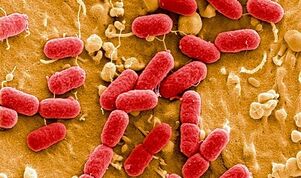
- E. coli and Pseudomonas aeruginosa;
- staphylococcus and streptococcus;
- chlamydia;
- ureaplasma;
- Trichomonas;
- fungal flora.
The infection enters the prostate in three ways: through the flow of blood, through the lymph, or through the urethra. The last route of pathogen entry is in case of chlamydia, ureplasma, or Trichomonas infection.
Causes of the disease:
- decreased immunity;
- severe hypothermia;
- stress;
- Long-term antibiotic therapy.
Conditionally pathogenic bacteria are always present in the body and only strong immunity does not allow them to be activated.
Chronic bacterial prostatitis develops in an acute form in the following cases:
- the presence of a chronic focus of infection;
- incorrectly selected antibiotic therapy;
- late treatment discontinuation;
- weakened immunity.
In most cases, the chronic form of the disease develops precisely because of improper treatment. This occurs when the antibiotic therapy regimen is not properly prepared or self-medication. Stopping antibiotics when you feel better will result in the pathogen not being completely killed. Any decrease in immunity or hypothermia in this case will lead to recurrence of the disease.
The most difficult to treat is fungal prostatitis caused by yeast-like fungi. This pathogen rapidly develops resistance to antifungal drugs, which makes treatment difficult and increases the risk of developing a chronic form of the disease.
Symptoms of the disease
In chronic prostatitis, the symptoms are mild, but the disease gets worse with reduced immunity or after stress.
The most common symptoms of chronic prostatitis in men are:
- urinary disorder;
- difficulty in the prostate;
- weakening of potency;
- Night urge to use the toilet.
As exacerbation of chronic prostatitis, pain in the bladder and perineum is observed. The frequency of urging to the toilet can reach 10 per hour. However, the flow of urine is poor, the muscles need to be stretched to the urine, but the process itself does not bring relief, and repeated urges appear after a few minutes.
The symptoms and treatment of chronic prostatitis depend largely on the form of the inflammation. Erectile dysfunction is common in congestive prostatitis. This is due to impaired blood circulation. Ejaculation can occur quickly or be completely absent due to thickening of prostate secretion.
In case of infectious inflammation of the prostate gland or chronic bacterial prostatitis, pain may occur during urination and urethra may burn after ejaculation. Such symptoms are accompanied by irritation of the urethral mucosa with agents that cause diseases in the secretion of the prostate.
Prostatitis and erectile dysfunction

Inflammation of the prostate is not visible to the eye, there are no visible manifestations of symptoms of chronic prostatitis, but they indicate internal abnormalities. One of the characteristic symptoms of the disease is a weakened erection.
Erectile dysfunction develops in several stages in congestive prostatitis. The disease itself develops over a long period of time, with no apparent symptoms, and signs of prostatitis appear only with a strong weakening of the immune system.
Bacterial inflammation of the prostate is suspected by changes in erection. An increase in potency is observed at the onset of the disease. It excites the man quickly, but ejaculation also comes quickly. This is due to a change in the viscosity of the prostate gland secretions. There may be discomfort during ejaculation, but pain is characteristic of infectious but non-congestive prostatitis.
This causes a number of psychological problems that aggravate the course of the disease. Erectile dysfunction due to blood flow problems is exacerbated by fear of the sexual partner, which can lead to the development of impotence in the background of prostatitis.
Urinary Disorders
Problems with urodynamics can be observed in all forms of prostatitis.
Chronic bacterial inflammation is characterized by a nocturnal urination. This is caused by swelling of the prostate gland, which gets worse at night. Urinary pressure is weakened and there is a need to tighten the pelvic floor muscles to urinate. However, you may feel heaviness and fullness in your bladder and occasionally cramps may occur. Due to the frequent desire to use the toilet at night, sleep problems and insomnia appear. All of this affects a man’s mental state and further aggravates the course of the disease, as the background of stress decreases immunity and slows down metabolic processes.
Men often complain of lower abdominal cramps, which can be explained by the increased tone of the bladder muscles. Generally, severe symptoms of prostatitis are seen with a decrease in immunity. Without exacerbation of the disease, pain syndrome may be completely absent.
Congestive prostatitis is characterized by severe prostate edema. The contours of the organ become blurred, the prostate itself swells and enlarges. In this case, a feeling of fullness and increased discomfort in the rectum may occur during bowel movements. Problems with urination are due to the urethra being compressed by the swollen prostate.
Why is prostatitis dangerous?
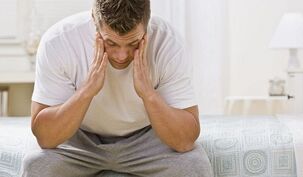
The consequences of chronic prostatitis depend on a number of factors:
- patient age;
- severity of symptoms;
- current duration;
- The effectiveness of drug therapy.
The longer a man lives with chronic prostatitis, the more severe the consequences of the disease. In most cases, the urinary system is affected. In the case of bacterial prostatitis, kidney infection can occur when urine flows back. This is due to the penetration of pathogens into the urethra during ejaculation.
Constant irritation of the bladder and urethra can lead to inflammation. Various types of cystitis and urethritis are often diagnosed in the background of prostatitis.
In chronic prostatitis, the consequences affect a man’s psycho-emotional state. Violation of potency, frequent urge to use the toilet, discomfort in the bladder - all this leads to stress. Prostatitis can be an indirect cause of neurosis and depression.
Disruption of the nervous system leads to a decrease in immunity and deterioration of all metabolic processes in the body in the background of constant discomfort of the urogenital organs. Thus, prostatitis causes nerve disorders, which in turn aggravate the course of the disease and close the circle.
Constant discomfort, violation of potency, inability to sleep - all of which greatly affect the quality of life.
Disease Diagnostics
If you suspect inflammation of the prostate, consult a urologist or andrologist. The following diagnostic methods are used to make a diagnosis:
- rectal palpation of the prostate;
- Ultrasound and TRUS of an organ;
- renal ultrasound;
- analysis of prostate secretion;
- PSA blood test.
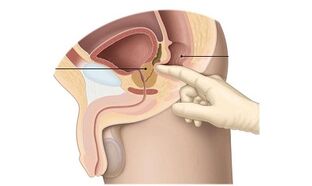
The need for further examinations is determined after palpation of the rectal organ. This procedure is also known as prostate massage. The doctor inserts two fingers into the opening in the rectum and feels the prostate. Inflammation is evidenced by changes in organ structure, heterogeneity of tissue and prostate contours. During the massage, the organ is stimulated and the secretion of the prostate is excreted from the urethra. Collected for further analysis. Analysis of prostate secretion shows the following:
- amount of lecithin particles;
- leukocyte and erythrocyte count;
- presence of pathogenic microorganisms; Presence of
- fungal microflora.
This makes it possible not only to determine the nature of the inflammatory process, but also to identify the pathogen of infectious prostatitis.
Ultrasound and TRUS are performed to exclude stones in the prostate rather than to diagnose prostatitis because the method, unlike the analysis of secretions, is not very informative.
PSA blood tests are prescribed to rule out oncopathology of the prostate gland. It also detects inflammation or prostate adenoma. The treatment of chronic prostatitis depends on the test results and the type of inflammation.
Treatment Features
The treatment regimen for chronic prostatitis is a combination of medication, physiotherapy, and folk methods. The treatment is complemented by lifestyle changes - changing the menu, giving up bad habits, regular sports and sex life.
It is important to understand that in chronic prostatitis, treatment takes at least six months. In addition to anti-inflammatory drugs, men are prescribed long-term rehabilitation therapy, which is needed to normalize prostate function.
Medication
How you treat chronic prostatitis depends on the form of the disease. Medications for chronic prostatitis include:
- antibiotics or anti-inflammatory drugs;
- rectal suppositories to normalize trophism;
- Immunostimulants and restorative agents.
Antibiotics are used to treat chronic prostatitis in men, but only if it is an infectious inflammation of the prostate. The treatment of infectious prostatitis in men depends on the pathogen and the success of the previous course of therapy. In the case of acute bacterial inflammation, macrolide antibiotics are prescribed in most cases. They effectively suppress the activity of pathogens and are broad-spectrum. If the treatment regimen is not followed or the drugs are not selected properly, the microorganisms that cause inflammation quickly develop resistance to macrolides, which largely causes the disease to progress to a chronic form.
Fluoroquinolones are effective antibacterial drugs for prostatitis caused by microorganisms. They have a pronounced anti-inflammatory effect against a wide range of pathogenic microorganisms.
Although fluoroquinolones do not have natural analogues, which is why pathogenic microorganisms are not resistant to the drug, the treatment regimen chosen by the physician should be carefully followed. Otherwise, the drug will be ineffective and antibiotic therapy should be repeated.
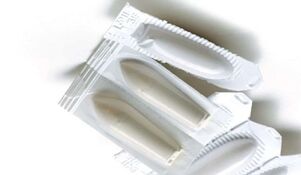
Antibacterial drugs and tablets are not used to treat chronic, non-infectious prostatitis. In the case of congestive prostatitis, the inflammation is not caused by microbes but by a violation of trophism, so it is not appropriate to use antibiotics for treatment. Anti-inflammatory drugs are used instead. It is used in short courses to reduce inflammation and swelling. The drugs are prescribed in suppositories or injections. The treatment lasts an average of one week, and the drug is administered rectally or intramuscularly once a day at night. In case of severe inflammation, it is possible to use the drug twice a day.
Anti-inflammatory drugs are not antibiotics. The tablets have been used successfully to relieve the inflammatory process with non-infectious or congestive prostatitis. Doctors prescribe an average of two tablets for 5 days and then take the patient to therapy with phytopreparations that improve prostate trophism.
In case of severe urinary disorders, treatment is supplemented with medicines belonging to the group of alpha-blockers. These medications relax the bladder, reducing muscle tone, thus allowing normal urine flow. Drugs in this group are taken as one tablet a day for short courses, and treatment with alpha-blockers rarely exceeds one week.
After the inflammation has stopped, congestive (cognitive) and infectious prostatitis are treated with drugs that normalize the trophism of the prostate gland. Medications contribute to:
- reduces inflammation;
- analgesia;
- normalize urination;
- increase potency.
In chronic prostatitis, these drugs are used for at least two weeks. They come in the form of rectal suppositories. The recommended dose is one candle a day.
Propolis suppositories are recommended to restore local immunity. They relieve inflammation, improve blood circulation and outflow of prostate secretions, and significantly increase immunity, preventing the exacerbation of prostatitis. The drugs come in the form of small suppositories that are injected into the rectum at night.
In addition, your doctor may recommend ichthyol suppositories. They relieve inflammation and reduce swelling of the prostate.
Preparations based on echinacea extract are recommended as a general tonic for prostatitis. They strengthen the immune system and prevent the development of worsening prostatitis. With the appearance of neuroses and insomnia in the background of prostatitis, your doctor may recommend sedatives.
Physiotherapy for chronic prostatitis
The causes of chronic prostatitis lie in the poor circulation of the pelvic organs. Physiotherapy methods are widely used to accelerate prostate healing and recovery:
- magnetic therapy;
- electrophoresis;
- shock wave therapy;
- acupuncture.
Acupuncture (acupuncture) and leech therapy (hirudotherapy) are distinguished from non-traditional methods.
There are many methods of home physiotherapy. The most popular are special tools. They create alternating magnetic fields that have a positive effect on metabolic processes, eliminating congestion in the pelvic organs.
Darsonvalization can also be used at home. It is a microconductive effect that improves metabolic processes. You can buy home treatment items at any medical device store, but it is recommended that you consult your doctor first.
Prostate massage is used to treat congestive prostatitis. Specialist performs in a medical institution. Stimulation of the organ allows it to get rid of swelling and discomfort and also relieves stagnation of prostate secretions. The course consists of 10-15 procedures.
Folk remedies
The treatment of chronic prostatitis depends on the range of therapeutic measures taken. Traditional medicine helps to supplement medication.
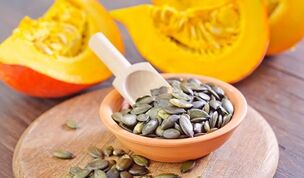
Homemade suppositories are used to relieve inflammation of the prostate. To make the candles, you will need 200 g of greasy base, 40 ml of propolis extract. The base is melted in a water bath, the propolis is poured into it slowly with constant stirring. When the product gets a uniform color, it is poured onto food film and packaged in the form of a sausage. The mass should be refrigerated for one hour. When the product has cooled, it is divided into torpedo-shaped pieces equal to a knife, about 5 cm long and 2 cm in diameter. These candles should be stored separately, packaged in the refrigerator. The recommended dose is a suppository in the anus before going to bed. The duration of treatment is 2-3 weeks.
You can also make candles with pumpkin seed oil and honey. The ratio is 200 g of base, 50 ml of oil and 3 tablespoons of honey. It can be based on beeswax, lanolin, cocoa butter. Such suppositories relieve inflammation, improve prostate function and increase immunity.
You can use a variety of infusions and decoctions to treat chronic prostatitis at home. One of the most effective remedies is parsley juice. Take 3 large spoons daily.
Traditional medicine recommends consuming 30 g of pumpkin seeds a day. They contain many nutrients that are necessary for the normal functioning of the prostate.
Another effective treatment is a mixture of pumpkin seeds, nuts and honey. To prepare the medicine, you need to bring in 100 peeled seeds and the same number of walnut seeds, place in a convenient container and pour 500 ml of honey. The product is kept in the refrigerator for 4 days to receive an infusion and then 4 large spoons are taken daily.
Surgical treatment
Whether chronic prostatitis is permanently curable depends on the severity of the disease and the age of the patient. In case of frequent exacerbations, you should keep taking the drug.
Surgery for prostatitis is not performed in most cases. Perhaps the application of radical measures - the complete removal of the prostate. Such an operation is performed only if the prostate does not perform its functions due to chronic inflammation and the medication is ineffective. In addition, prostate removal is practiced with the risk of developing oncology.
Interestingly, the effects of prostatitis are usually observed in the elderly, in men over 65 years of age. This raises a number of difficulties in treatment:
- cardiovascular diseases;
- contraindications to taking drugs;
- many side effects.
Many men who have had prostatitis for more than 10 years insist on surgery. This is usually associated with poor drug tolerance and many side effects. Doctors say surgery is the ultimate solution, with the right approach to treating prostatitis with conservative methods.
Prevention and prognosis
Once we realize what chronic prostatitis is in men and how dangerous it is, the question immediately arises as to whether the disease is completely curable.
Patient recommendations show that chronic prostatitis is curable, but it will take a long time. The course of treatment lasts an average of six months or more. Urologists agree that proper therapy, lifestyle changes, and a balanced diet can help get rid of inflammation.
Exacerbations and recurrent inflammatory episodes after prolonged remission are most common in men who do not follow the doctor's recommendations but are treated according to the advice of their friends. It is important to understand that the success of therapy depends on the right choice of drug therapy. May lead to worsening or recurrence of signs of chronic prostatitis:
- systemic drug administration;
- non-compliance with doctor's recommendations;
- stop treatment after the first enhancements;
- bad habits;
- lack of physical activity.
Self-medication often leads to worsening of well-being. This is especially true for infectious inflammation, where the patient selects antibiotics independently without testing.
A common mistake men make is to stop treatment when the first improvements appear. In this case, the inflammation does not go away, but only decreases for a while. As immunity or hypothermia decreases, the disease will feel again.
In addition to medication, prostatitis requires lifestyle changes. It is important to give up bad habits, normalize your diet and start exercising. In case of prostatitis, it is recommended to do yoga, exercise and swimming. Any workout that includes the pool will be beneficial. Men in this condition, especially sedentary work, should do 10 minutes of exercise every day and do a full workout several times a week. In addition, sex is required in the treatment of chronic prostatitis, as regular ejaculation helps reduce prostate edema.
The success of treating prostatitis depends on a timely diagnosis, so if you notice urinary problems, consult a urologist as soon as possible.
































